In Texas, A 400-Acre Muslim Development Sparks Controversy
Authored by Darlene McCormick Sanchez via The Epoch Times,
JOSEPHINE, Texas - This rural town with farmland stretching to the horizon might as well be a million miles away from New York City with its skyscrapers and big-city worries.
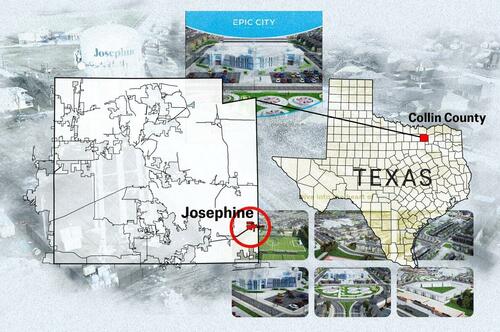
But the residents of the Big Apple and Josephine have something in common—controversy over the construction of a mosque.
Perhaps not since the “Ground Zero Mosque” was proposed two blocks from the World Trade Center site of the Sept. 11 terrorist attacks has a mosque drawn so much attention.
The proposed 2009 Manhattan mosque and Islamic cultural center was known as Park 51. It faced sharp public criticism for plans to place a symbol of Islam so close to where thousands died from an attack by radical jihadists. Groups such as Stop Islamization of America led protests against “radical Islam” before the project was eventually abandoned.
More than a decade later, as Muslim migration to Texas has increased, a similar uproar has risen over a proposed Muslim-focused neighborhood anchored by a mosque in rural Texas, some 40 miles from Dallas.
Promotional materials first described EPIC City, named after the East Plano Islamic Center, as the “epicenter of Islam in America.”
Following backlash at the local, state, and federal levels, it changed its name to The Meadow.
The development would encompass 402 acres of farmland outside Josephine, a town of 8,800 residents founded in 1888 by a railroad company back when cotton was king in Texas.
It would include 1,000 homes, a mosque, a K-12 faith-based school, sports facilities, a community college, senior housing, an outreach center, and businesses.
Since the idea was proposed, numerous public officials and community members have worked to halt the development, citing concerns about whether the new community would integrate with the local population and asking questions over sharia—Islamic law—and potential ties to foreign Islamic groups.
The development has prompted legal battles, state and federal investigations, and new state laws addressing neighborhood composition and foreign ownership. The ongoing battle included Texas Gov. Greg Abbott classifying some Islamic groups as foreign terrorist organizations; and the White House is considering similar action.
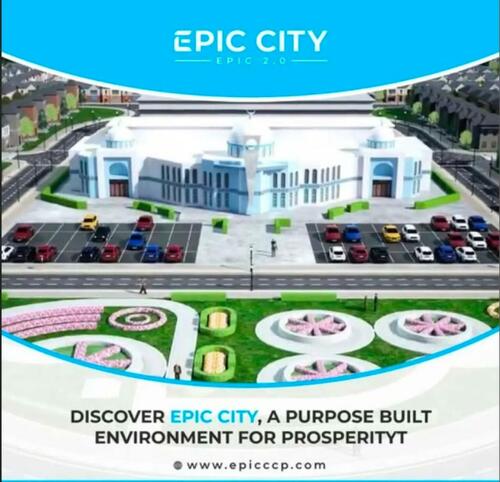
A new mosque is the centerpiece of the proposed EPIC City, described as the “epicenter of Islam in America.” The city was renamed The Meadow after backlash at the local, state, and federal levels. Republican leaders, including Texas Gov. Greg Abbott, and residents have opposed the proposed 402-acre Muslim development outside the rural town of Josephine, Texas. Rendering from Texas legal documents
Grassroots Backlash
The Muslim-led community would be located in an area largely populated by white and Hispanic residents whose religion is predominantly Christian.
Locally, residents have voiced concerns about Islamic radicalization and sharia law in communities they believe may not integrate into U.S. culture, despite the developer’s denials.
Sharia law is an Islamic code of conduct and law derived from the Quran, often at odds with laws and rights in Western countries.
One woman who spoke at a Collin County Commissioners Court meeting in November raised concerns that sharia would replace U.S. law within the development.
“This remains an Islamic-focused community, and Islam is fundamentally incompatible with our Constitution,” she said.
At the Josephine City Council meeting, a resident of Armenian descent said people should be aware that, in his view, Islam is only peaceful when it is not in control.
“Islam is not truly a religion of peace,“ he added. ”Once they get to a certain point in a culture, they start to ravage it from within.”
Most Muslims are good people, he said, but when their religious ideology demands it, they feel compelled to obey. “They don’t speak up against it.”
He referenced historical events, saying the West should consider the Armenian genocide over a century ago under the Ottoman Empire, which imposed sharia.
“We were walked into the Syrian desert until we died of hunger, of starvation. They hung Christian females to posts and lit them on fire as candles,” he said.
As public concerns intensified, state officials stepped up their efforts to address them.
Earlier this month, Texas Attorney General Ken Paxton announced a lawsuit against the East Plano Islamic Center (EPIC), which contracted for the land, and developer Community Capital Partners, and others, alleging violations of Texas securities laws.
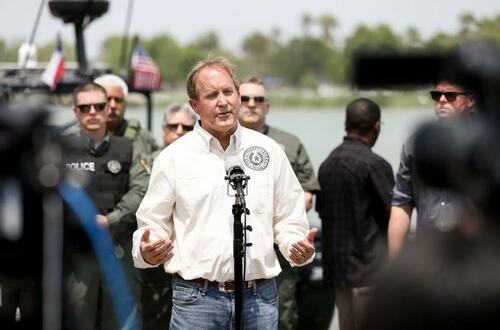
Texas Attorney General Ken Paxton at a press conference in Anzalduas Park near McAllen, Texas, on April 28, 2021. Charlotte Cuthbertson/The Epoch Times
The lawsuit claims the housing development would be illegally reserved for Muslim residents. It also asserts that the project’s leaders “lined their own pockets” with funds during development.
Abbott took to social media on Dec. 3, stating the development’s name change does not alter its intent and that at least four state agencies continue to investigate “this misguided mission.”
“‘The Meadow’ will remain just that—an empty meadow,” Abbott said. “EPIC can change its name, but can’t change the legality of the flawed structure they seek to impose. They delete social media posts & rewrite contracts. But it’s just a disguise to impose sharia on a community they create.”
Developers Say No Wrongdoing
Meanwhile, the Texas enclave’s developers and Muslim groups have denounced the legal action as Islamophobic and a violation of their rights.
The Islamophobia Network, a project of the Council on American-Islamic Relations (CAIR), produced a report about the development condemning Abbott’s actions as politically motivated.
“Anti-Islam organizing targeting the Muslim-led EPIC City development project saw bias mobilizing the power of Texas government to deny Muslims their equal opportunities to pursue their dreams and potential,” the report said.
It denounced what it called “anti-Islam” legislation and what it called “advanced conspiracy theories” involving “no-go zones.”
The report compared tactics used to stop the EPIC development to those used in the controversy over the “Ground Zero Mosque” at Park 51.
“We also note that Governor Abbott and Texas Attorney General Ken Paxton’s attack on EPIC City has not resulted in any evidence of wrongdoing to date and may violate Constitutional prohibitions against arbitrary government action,” the group stated.
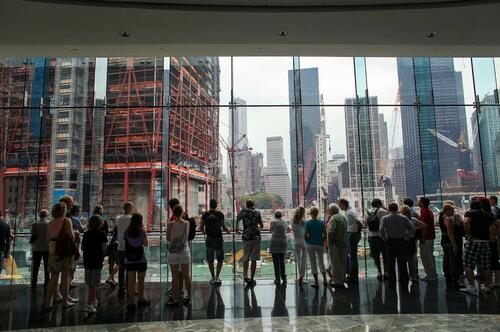
People watch construction at the World Trade Center site in New York City on Aug. 16, 2010. The proposed Manhattan mosque and Islamic cultural center, known as Park51, drew sharp criticism in 2009 over plans to locate it near the site of the Sept. 11 terrorist attacks. Spencer Platt/Getty Images
High-profile Texas attorney Dan Cogdell, who represents developer Community Capital Partners, held a press conference in the spring as the pressure campaign against the development ramped up.
“My clients are law-abiding Texans, law-abiding Americans, and law-abiding Muslims,” he said.
He added that no one associated with the community follows or implements sharia and that Abbott was attempting to “demonize” Muslims.
Neither EPIC nor Cogdell responded to requests for comment.
State Legislation
Republicans campaigning in the Lone Star state are tapping into public unease over mass immigration and the increase in terrorist incidents, such as the Nov. 26 shooting of two Washington D.C. guardsmen by an Afghan immigrant.
Abbott is currently seeking his fourth term as governor, while Paxton is running in the Senate Republican primary against incumbent Sen. John Cornyn (R-Texas).
In a flurry of activity this fall, Abbott took steps to block foreign threats and developments in Texas.
In September, he signed House Bill 4211 into law, banning residential property developers from creating exclusionary compounds, specifically citing the EPIC project.
Abbott stated that the law bans residential property developments such as EPIC City “from creating sharia compounds and defrauding and discriminating against Texans.”
“The fact is, religious freedom is a central part of the Texas Constitution. But bad actors like EPIC and EPIC City tried to use religion as a form of segregation. We will ensure that we have the laws and law enforcement in place to prevent attempts to build such discriminatory compounds in the state of Texas.”
Likewise, in June, the governor signed Senate Bill 17 into law, banning transnational criminal organizations and foreign adversaries—including Iran—from purchasing land.
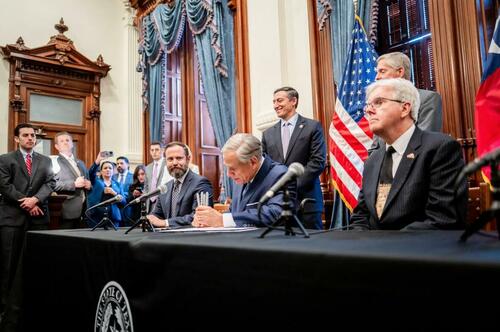
Texas Gov. Greg Abbott signs a bill at the state Capitol in Austin on April 23, 2025. Earlier this year, Abbott signed measures that would curb exclusionary residential compounds—citing the EPIC project—and restrict land purchases by foreign adversaries and transnational criminal groups. Brandon Bell/Getty Images
On Nov. 18, Abbott cited these laws in a proclamation designating the Muslim Brotherhood, which has ties to Hamas, and the Council on American-Islamic Relations (CAIR) as foreign terrorist organizations (FTOs) and transnational criminal organizations.
The designation authorizes “heightened enforcement against both organizations and their affiliates and prohibits them from purchasing or acquiring land in Texas,” according to the governor’s office.
Abbott took the additional step in December of asking Treasury Secretary Scott Bessent to suspend CAIR’s tax-exempt status, citing longstanding ties to the Muslim Brotherhood and Hamas.
CAIR filed its own lawsuit against Abbott and Paxton in November, calling Abbott’s proclamation “unconstitutional and defamatory.” The group said the proclamation falsely declared the Texas chapter of CAIR as a terrorist group.
A few days later, the White House announced it would investigate whether certain chapters of the Muslim Brotherhood should be designated as FTOs. Secretary of State Marco Rubio suggested during a radio interview with “Sid and Friends in the Morning” in August, that designating CAIR as a terrorist group was also “in the works.”
Other leading Republicans, opponents of Islamic extremism and sharia, have weighed in on the EPIC development.
In May, Cornyn said that the Department of Justice (DOJ) launched a civil rights investigation into the development at his request. The investigation was ultimately dropped with no violations cited.
Cruz, who reintroduced a bill in July to designate the Muslim Brotherhood as a terrorist group, said during a Heritage Foundation appearance that sharia law was a concern at the EPIC development in North Texas.
Last month, Rep. Chip Roy (R-Texas), who is running for Texas Attorney General, introduced legislation to counter mass migration. The bill would deny legal status to followers of sharia, known or suspected terrorists, and other groups.
“Many Americans strive to live their life practicing their faith, while our immigration system is actively importing radical Islamic sharia adherents and communists,” Roy said in a press release.

Demonstrators attend a rally with the Coalition to Honor Ground Zero in New York City on Aug. 22, 2010. The rally was held to oppose the construction of an Islamic Center and mosque near Ground Zero. Don Emmert/AFP via Getty Images
‘A Different Population’
Simon Hankinson, a senior research fellow at the Border Security and Immigration Center at The Heritage Foundation, said public fears over Muslim enclaves and mass migration are symptoms of a brewing national identity crisis.
Americans fear they are losing their culture and way of life to foreign influences, including those from the Middle East, he told The Epoch Times.
The foreign-born population of the United States currently sits at about 16 percent—the highest in history, according to the U.S. Census Bureau’s January 2025 Current Population Survey. The last time it was close to being that high was in 1890, when immigrants mainly from Eastern Europe pushed the foreign-born population to 14.8 percent, according to the Census Bureau.
“But obviously, now the Muslim population is growing rapidly with immigrants from the Middle East and North Africa—and it’s a cultural change,” Hankinson said.
“So it’s a new phenomenon. I think people, maybe in parts of rural Texas, were kind of used to the certain makeup that they had.”
More Americans are paying attention to immigration policy because it’s impacting their communities, he said.
Social media is awash in posts highlighting the effect of mass migration in Europe, warning that it’s a harbinger of things to come in America.
On Dec. 20, Tulsi Gabbard, director of National Intelligence, warned against “Islamist ideology” and sharia taking over the West during a speech at Turning Point USA’s AmericaFest
“This Islamist ideology is a direct threat to our freedom because at its core it is a political ideology that seeks to create a global caliphate that governs us here in America,” she said.
“If we don’t take action to identify this threat, to define it, to call it out for what it is, and take action to defeat it, then we will find ourselves in a place where many European countries and countries like Australia have found themselves.”

Director of National Intelligence Tulsi Gabbard speaks at Turning Point USA’s AmericaFest in Phoenix on Dec. 20, 2025. Gabbard warned against “Islamist ideology” and sharia taking over the West. John Fredricks/The Epoch Times
Hankinson, a British immigrant, said that native-born English citizens are now the minority in London.
“If you replace a population with a different population, then everything’s going to change,” he said.
But immigration is not accidental; it is a policy choice that voters make, he said.
Small groups of immigrants with cultures similar to those of the areas they move to tend to assimilate, such as Ukrainians settling in Poland, he said.
Enclaves of culturally diverse immigrants have been accepted when they are localized and relatively small, he said. But large groups of people coming into a country will change that society.
“I think Americans are noticing, and some of them probably don’t like it,” he said.
Ammon Blair, a security consultant and senior fellow for the Texas Public Policy Foundation’s Secure & Sovereign Nation Initiative, said the mass migration that occurred during the Biden administration was different from past migrations.
“This is a completely engineered, fabricated form of immigration where it’s done for the sole purpose of eradicating the sovereignty of a nation and state,” he told The Epoch Times.
Blair pointed to large immigrant settlements that sometimes remain under the control of the countries they left, making assimilation difficult.

Muslims pray at a mosque during Friday prayers in Plano, Texas, on April 11, 2025. Ronaldo Schemidt/AFP via Getty Images
This March, President Trump asserted in a proclamation that the Venezuelan transnational gang Tren de Aragua was part of the Cártel de los Soles, sponsored by President Nicolás Maduro’s regime. Tren de Aragua is known to target Venezuelan nationals in the United States.
Another example would be recent fraud rooted in Minnesota’s Somali settlement, which allegedly funds Al-Shabaab, a terrorist organization, he noted. Since then, President Donald Trump announced a crackdown on temporary legal status for Somalis.
“It all comes down to not just assimilation, but allegiance,” Blair said.
Hankinson said after experiencing immigration himself and watching countries change, he no longer believes multiculturalism works, saying it has probably “failed as an experiment.”
The ongoing debate over the proposed Muslim-centric development in Texas encapsulates larger questions about immigration, assimilation, and national identity across the United States, he said.
“The idea is that we can all live in one country, but we can have completely different values, beliefs, religions, cultural traditions, etc. I don’t think there’s enough to hold a country together without those things.”
Tyler Durden
Wed, 12/31/2025 - 17:45
 History professor James Hankins taught at Harvard for 40 years. (Sophie Park/Bloomberg)
History professor James Hankins taught at Harvard for 40 years. (Sophie Park/Bloomberg)




 Source: Washington Post/Getty Images
Source: Washington Post/Getty Images















 Handout: Anadolu/Getty Images
Handout: Anadolu/Getty Images Oreshnik, via Reuters
Oreshnik, via Reuters















 Thousand Sunny oil tanker (photo: Tommy Chia)
Thousand Sunny oil tanker (photo: Tommy Chia) Via Newsweek
Via Newsweek








Recent comments